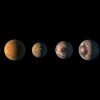The Trappist Planets and Magnetic Fields
By now, you’ve probably heard the news that NASA has discovered not 1, not 2, but 7 “Earth-like” planets revolving around nearby dwarf star, Trappist-1. These planets are thought to be in the habitable zone and could maybe, one day, sustain human life.
Sound familiar? That’s because we’ve heard this story before. Last summer, a similar planet known as Proxima B was found orbiting one of our solar system’s nearest neighboring stars, Proxima Centauri. This planet was also touted as having the potential to sustain human life. However, there was one very big issue: a magnetic field.
Meet the New Neighbors
Before we get too pessimistic, let’s examine some of the Trappist planets a little more closely to see who our top contenders are. To start, only three of the seven planets occupy what’s known as the “habitable zone.” In other words, they are just the right distance from their star to even qualify for life as we know it.
However, this is not the sole requirement. At 40 light years away, we know very little about the makeup of these extragalactic entities. As mentioned earlier, a lot of it comes down to the presence of an adequate magnetic field. However, just to complicate things a little more, we need to consider the star, Trappist-1, itself.
Trappist-1 is a red dwarf star. Red dwarfs are the most abundant type of star because they require less energy to sustain themselves. Many are young stars, albeit still millions upon millions of years old. Like most youngsters, red dwarves can be unpredictable. Massive solar flares, the size of which we definitely don’t experience from our sun, are common. This spells pretty big trouble for any nearby planets.
The subtext here is that not only would these three contending planets need magnetic fields, they’d have have to be pretty darn strong to stand up to their sun’s temper tantrums.
No Magnetic Field, No Earth
As our own planet demonstrates, unless there is evidence of a capable magnetic field, most of the Trappist-1 planets are going to be DOA, certainly the ones in the habitable zone. That’s because stars give off huge amounts of radiation in the form of solar wind. Unless your planet has some sort of deflector shield (read: magnetic field), said planet will have no hope of developing an atmosphere, let alone life.
This was the fate of Proxima B. As scientists examined the newfound planet, it was quickly uncovered that the planet did not possess the needed magnetic field and was therefore just an irradiated hunk of rock orbiting in space.
But there’s still reason to be hopeful. Space exploration has really accelerated in recent years. Scientists can barely keep up with all the new discoveries. We’ll be sure to keep you posted with all the latest news. Make sure to visit our blog regularly!

